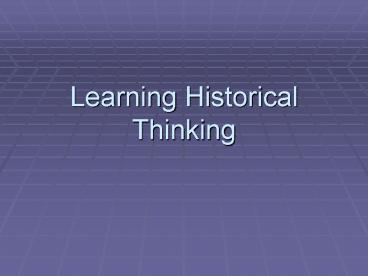Learning Historical Thinking - PowerPoint PPT Presentation
1 / 19
Title: Learning Historical Thinking
1
Learning Historical Thinking
2
Background
- To think historically is essentially to be a
critical thinker when it comes to the study of
history. - Peter Seixas,
- University of British Columbia
3
6 Concepts of Historical Thinking
- Significance
- Evidence
- Continuity Change
- Cause Consequence
- Historical Perspective-taking
- The Moral Dimension (Judgment)
4
Significance
- Events, people or developments have historical
significance if they resulted in change. That is
they had deep consequences, for many people, over
a long period of time. - Events, people or developments have historical
significance if they are revealing over a long
period of time. That is they shed light on
enduring or emerging issues in history or
contemporary life. - Historical significance is constructive. That is
Events, people or developments meet the criteria
for historical significance only when they are
shown to occupy a meaningful place in a
narrative. - Historical significance varies over time and from
group to group.
5
Evidence
- Problem the past is gone. So, how do we know
about it? Through evidence. - History is an interpretation based on inferences
made from primary sources. Primary sources are
made from accounts but they can also be traces,
relics, or records. - Asking good questions about a source can turn it
into evidence. - Sourcing often begins before a sources is read,
with questions about who created it and when it
was created. It involves inferring from the
source the authors or creators purposes, values
and worldview, either conscious or unconscious. - A source should be analyzed in relation to the
context of its historical setting the
conditions and worldviews prevalent at the time
in question. - Inferences made from one source can never stand
alone.
6
(No Transcript)
7
Continuity and Change
- Continuity and change are interwoven both can
exist together. - Change is a process with varying paces and
patterns. Turning points are moments when the
process of change shifts in direction or pace. - Progress and decline are broad evaluations of
change over time. Depending on the impacts of
change, progress for one people may be decline
for another.
8
The IBM 7094, a typical mainframe computer photo
courtesy of IBM
9
(No Transcript)
10
Cause Consequence
- Change is driven by multiple causes and is driven
by multiple consequences. - The causes that lead to a particular historical
event vary in their influence, with some being
more important than others. - Events result from the interplay of two types of
factors - Historical actors, who are people (individual or
groups) who take actions that cause historical
events, and - The social, political, economic and cultural
conditions within which the actors operate.
11
Cause and Consequence
- The events in history were not inevitable, any
more than those of the future are. Alter a
single action or condition, and an event might
have turned out differently. - unintended consequences
- Part II
- Part III
12
Columbine
Marilyn Manson
13
Historical Perspective
- Presentism is the opposite of historical
perspective. Presentism is when you examine the
past through todays understandings (values,
norms, technological understanding) - The goal, when thinking historically, is to avoid
presentism.
14
Moral Judgment
- Authors make ethical judgments in writing
historical narratives. - Reasoned ethical judgments of past actions are
made by taking into account the historical
context of the actors in question. - When making ethical judgments it is important to
be cautious about imposing contemporary standards
of right and wrong on the past. - A fair assessment of ethical implications of
history can inform us of our responsibility to
remember and to respond to the contributions,
sacrifices and injustices of the past.
15
(No Transcript)
16
What about local history?
17
(No Transcript)
18
- http//cct2.edc.org/PMA/image_detective/model_read
ing3.html
19
Thinking historically
- Make inferences about life around town at that
time - Consider the societal, economic, technological
environment - Compare with photos of the same place today
- Identify a list of things that have changed and
stayed the same - http//www.histori.ca/benchmarks/































